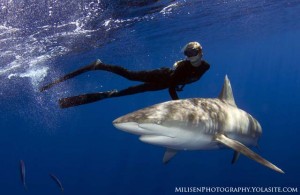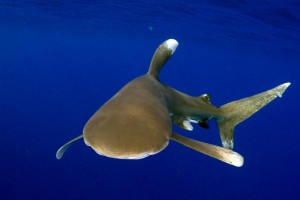The Case for Shark Feeding
The Case for Shark Feeding
Today’s environmentalist has every reason to lose their mind.
Excess carbon emissions have woven an earth-sized gaseous duvet that is now smothering us with warmth. That same carbon has created an ocean of battery acid, eroding the calcareous shells of organisms that used to form the base of the oceanic food chain. Littered plastic clogs the digestive tracts of seabirds while our beloved whales adorn themselves with derelict fishing gear. Commercial fishing has removed 90% of the world’s food fish from the sea. Treating the ocean like mankind’s personal sewer is catching up to us at unprecedented rates while global environmental awareness is advancing at the speed of smell. So please carry the environmentalist torch forward as it is already fighting against a building tide. However, do so carefully, as it is of paramount importance to get the message right to avoid looking like lunatics. Under the topic of accuracy, it is time to set the record straight on another controversy that is holding back progress. That issue is shark feeding dives. Here’s why.

A Few Numbers
At the heart of this debate lies a case of bad PR. According to the International Shark Attack File, 2013 was a deadly year for shark attacks with 16 shark related deaths. To put that into perspective, boating accidents accounted for 651 deaths in 2012 (USCG) and the CDC recently reported that drowning was the second leading cause of unintentional death in children aged 1-14. You are more likely to die in a vending machine altercation than by a shark.
If the culling movement is barbaric by today’s standards, finning is outright genocide.
And yet sharks always seem to land the villain role in movies, creating an atmosphere of panic at the mere mention of the animal. In a reaction to high-profile shark mishaps, targeted culling programs in the 1970’s were intended to reduce the numbers of large sharks in an area. While culling is still discussed today following shark incidents, it was shown to be largely ineffective and is rarely practiced. If the culling movement is barbaric by today’s standards, finning is outright genocide. Some species have seen declines of more than 95%. Pelagic sharks suffer the worst, as they have no marine protected areas in which to hide. Oceanic whitetips, which only 60 years ago were thought to be the most abundant large animals on earth, were placed under the protective care of CITES this year, largely due to the market for their fins. So sharks are in trouble and need help, fast.

How Shark Dives Help
Shark conservation needs professional shark dives. Face-to-face encounters with dolphins, manatees and stingrays have garnered an attentive army of conservation supporters. The mix of neurotransmitters released during such experiences can be an overwhelmingly positive experience that leaves guests breathless. Shark encounters have the same awe-inspiring effect. Shark divers love bragging to their friends of the incredible encounter they had on vacation, further spreading the good vibe through simple word of mouth.
Word of mouth isn’t enough. To drive the point home, the world needs media, and lots of it, to drown out the infrequent biting incidents that continue to make headlines. The first rule of underwater photography is to get close, then get closer. Photographers, videographers and writers all need to get as close as possible to render the best stories they can. Chance shark encounters sans the chum are possible with some species, but are rare and unreliable. The best way to get top quality sharky media is with bait.
Live sharks are valuable, and responsible exploitation of that resource means shark diving.
Finally, shark dives give live animals an economic value. Politicians and businessmen speak in dollars. Shark ecotourism is currently a growing $314 million per year industry. Researchers in Palau calculated that each live shark inhabiting the local dive sites was worth $1.9 million. Finned and sold as meat, those same animals would have fetched a mere $10,800. Add to that the uncalculated loss of ecological services contributed by top predators in an oceanic food chain. Live sharks are valuable, and responsible exploitation of that resource means shark diving.

Righting Wrongs
The Hawaiian community is an example of a typical public reaction to shark feeding dives. There are two operations on Oahu that take customers 3 miles offshore to cage-dive with Galapagos and sandbar sharks. They are constantly protested in the news and eyed with suspicion and resentment by many in the community. These citizens are concerned because Oahu’s north shore is a popular place for water recreation. However, the three main arguments against the operations are based largely on misconceptions and assumption:
Sharks associate people with food – There is no evidence to support an association of people with food and based purely on speculation. Sharks associate food with food. Personal experience has shown that humans can still enter the water safely at the Oahu shark dive sites without a cage. Not only do the sharks mostly ignore free-swimmers without bait, they are scared away by the strange creatures. Other shark dives in Fiji, Moorea, South Africa and the Bahamas have solid safety records with one fatal bite out of many thousands of shark diving participants.
Sharks follow the boats back to shore – The idea that hungry sharks associating boat noises with food follow the boats back to shallower water was the most often cited complaint of the companies on Oahu and again was based only on speculation. A study was performed by the University of Hawaii to study this very question. Tags were implanted on the animals at the dive site. Receivers were strategically placed in the transit back to harbor that would detect every time a tagged animal swam by. Their data found no evidence suggesting that the sharks followed the boats back. Instead, the animals stayed at the buoy sites even when the boats weren’t there. Furthermore, the researchers found that the shark species assemblage was seasonal. This suggests that the sharks’ behavior is not altered so heavily that they fail to maintain normal migration activities.
The operations disrespect sharks – Deeply seated in Hawaiian culture is the idea of a spirit guardian or aumakua taking the form of an animal. Sharks are a commonly cited aumakua, so they are highly respected. Many believe that the act of feeding or taking tourists to see them is a show of disrespect. While the animals are on display, the visitors are given lengthy lessons in local culture and shark conservation. At one time the animals were rewarded with small amounts of food for their participation. Certainly the sharks didn’t feel disrespected.
Even still, hot debates rage on. A few years ago an operator was politically chased out of Hawaii Kai Harbor for trying to start a similar operation. Every time a swimmer is bitten on the north shore of Oahu, the incident is falsely traced back to the operations 3 miles offshore. Accusers fail to recognize that shark attacks on Oahu are exceedingly rare in spite of the gargantuan population of human ocean users.

In Conclusion
Wrong information has been presented as fact since long before Galileo was threatened with excommunication from the church for his theory on heliocentrism. The internet has just given the misinformed and misguided a platform on which to preach. The result is an enormous record of opinions mostly based on poorly interpreted science or just plain hogwash. For example, the maps showing Fukushima’s oceanic fallout were just falsified NOAA tsunami maps. Need proof? Check the units in the original map, they were in cm of sea level rise, not rads. Stories of radioactive fish were based on a single study that used trace amounts of radioactive material to figure out where the fish had migrated-the key word being “trace.” The study animals contained less radiation than your average day at the beach.
The rash of false causes spurred by the internet has stolen attention away from the real issues. In this case, overfishing has decimated apex predator populations worldwide. Sharks have it especially rough because they are often seen as violent oceanic criminals.
The shark world needs shark ecotourism even if it means baiting. It is the only way to change the world’s opinion.
Do you think shark feeding is justified? Let us know in the comments below.
- The Case for Shark Feeding – March 27, 2014
- Create Your Own Luck – January 26, 2014
- Starting out in Underwater Photography – December 25, 2013

 CAD
CAD
1 comment
The sharks had become so aggressive she had to get out of the water….
The Florida Dive boat operators were trying to skirt the regulations. Read about the investigation that led to their arrests.
Protect and save sharks and divers. http://chn.ge/1qjxitC